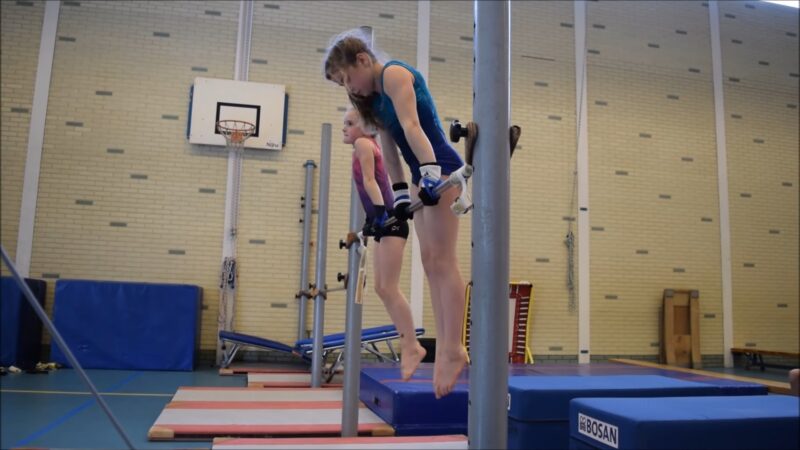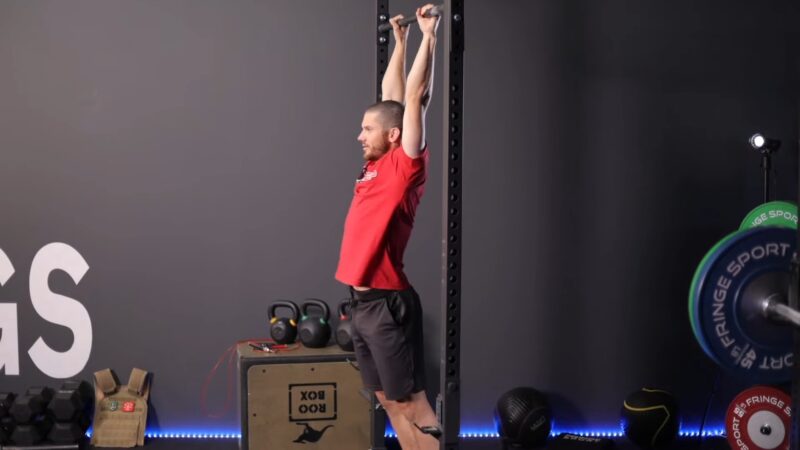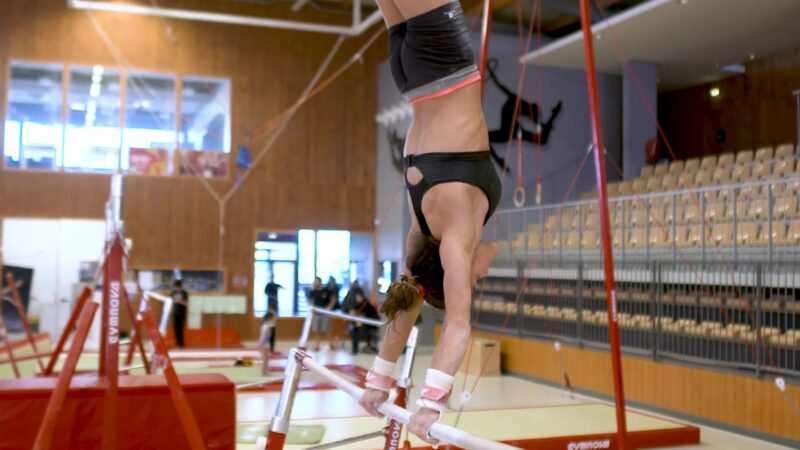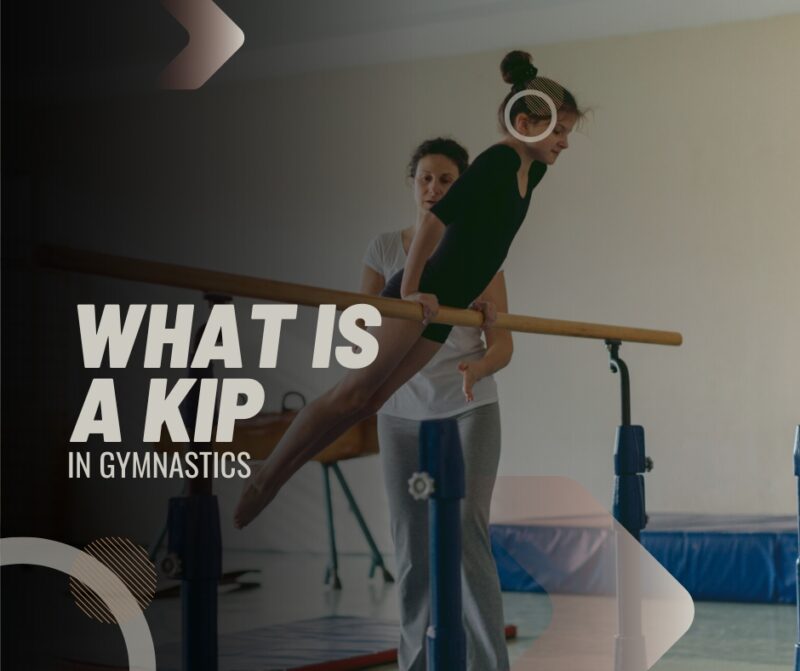Fellow gymnastics enthusiasts! Today, we’re going to dive into a move that’s as essential to gymnastics as the perfect dismount – the kip. This is no ordinary move, my friends. It’s a rite of passage, a gymnastics milestone that marks the transition from beginner to intermediate. It’s the gymnastics equivalent of your first bike ride without training wheels.
I still remember the first time I executed a kip. I was a young gymnast, full of energy and determination. My coach, a seasoned veteran with a keen eye for talent, watched as I approached the bars. With a deep breath, I launched myself into the move. One moment I was hanging from the bars, the next, I was on top of them, heart pounding with the thrill of success. My coach’s approving nod was the cherry on top of that memorable day.
From that moment, I knew the kip was more than just a move. It was a symbol of progress, a testament to hard work and perseverance. And today, I’m here to guide you on this exciting journey. So, let’s chalk up those hands and get ready to conquer the kip!
Understanding the Kip
What is it?
Now that we’ve set the stage, let’s get down to business. What exactly is a kip? In the simplest terms, a kip is a fundamental gymnastics move performed on the uneven bars. It’s a transition move that allows a gymnast to go from a hanging position below the bars to a support position above them. Sounds simple, right? Well, as any gymnast will tell you, it’s anything but!
The kip has its roots deep in the history of gymnastics. It’s been a staple of the sport for decades, and for a good reason. It’s a move that tests a gymnast’s strength, timing, and coordination, all in one swift, fluid motion. It’s like the Swiss Army knife of gymnastics moves – versatile, functional, and a little bit intimidating when you first encounter it.
I remember my first impression of the kip. I was a young gymnast, and the kip seemed like this insurmountable mountain. I looked at the bars, then at my coach, and thought, “You want me to do what now?” But as I soon learned, and as you will too, the kip is not a mountain. It’s a hill, steep and challenging, but absolutely conquerable with the right approach and plenty of practice.
Why is it Important in Gymnastics?
Now that we’ve got a handle on what a kip is, why is it such a big deal in the world of gymnastics? Well, you see, the kip isn’t just another move in a gymnast’s repertoire. It’s a cornerstone, a building block upon which many other skills are built.
Think of the kip as the gateway to the high bar. Without it, a gymnast would be stuck swinging below the bars like a kid on a playground swing. But with it, the entire landscape of the uneven bars opens up. Suddenly, the high bar is within reach, and with it, a whole new world of flips, twists, and turns.
Mastering the kip can significantly improve a gymnast’s overall performance. It’s a bit like learning to shift gears in a car. Sure, you could drive in first gear all day, but you wouldn’t get very far or very fast. The kip is the gear shift that propels a gymnast from the low bar to the high bar, from basic moves to more advanced ones.
And let’s not forget the sense of achievement that comes with nailing your first kip. It’s a moment of pure, unadulterated joy, a testament to the hours of hard work and dedication you’ve put in. It’s a bit like finally solving a tricky puzzle or beating a challenging level in a video game. The satisfaction is immense, and the confidence boost? Priceless.
The Mechanics
Now, let’s break down the mechanics of a kip. It’s a move that requires a blend of strength, timing, and technique, and understanding its mechanics is the first step towards mastering it.
- The kip starts with a glide swing. From a hanging position on the low bar, you’ll kick your legs forward and then backward in a smooth, pendulum-like motion. This is where the momentum for the kip is generated. It’s a bit like swinging on a swing set – the higher you want to go, the more momentum you need.
- Next comes the crucial part – the actual kip. As your legs swing forward again, you’ll need to pull your body up towards the bar. This is where your core and upper body strength come into play. It’s a bit like doing a pull-up but with a twist. Instead of pulling yourself straight up, you’ll need to pull your hips to the bar.
- Once your hips are at the bar, the final step is to push up into a front support position. This requires a quick, explosive push from your arms and shoulders. It’s the grand finale, the moment when you go from hanging below the bar to supporting yourself above it.
Now, if you’re thinking, “That sounds complicated,” you’re not wrong. The kip is a complex move, and it’s common for beginners to get tangled up in the mechanics. But don’t worry, even the best gymnasts had to start somewhere. And with practice, what seems like a jumble of kicks, pulls, and pushes will soon become a fluid, seamless movement.
Remember, the key to a good kip is smooth transitions. Each part of the move should flow into the next, like a well-choreographed dance. And just like a dance, it takes practice to get the timing and rhythm just right. But once you do, you’ll be kipping like a pro!
Mastering the Kip
How to Learn and Master the Move
Learning the kip is a journey, and like any journey, it starts with a single step. In this case, that step is building the necessary strength and flexibility. Core strength, upper body strength, and hip flexibility are crucial for a successful kip. Incorporating exercises like pull-ups, push-ups, and hip flexor stretches into your training routine can go a long way in preparing your body for the kip. Additionally, consider exercises like planks for core strength, tricep dips for upper body strength, and lunges for hip flexibility.
- Once you’ve built up the necessary strength and flexibility, it’s time to start practicing the individual components of the kip. Start with the glide swing. Practice getting a good, strong swing and generating enough momentum to carry you into the next part of the move.
- Next, practice the hip pull. This can be one of the trickiest parts of the kip to master, but don’t get discouraged. Remember, every gymnast struggles with this at first. It’s all about timing and technique, and the more you practice, the better you’ll get.
- Finally, practice the push into front support. This is where your upper body strength really comes into play. A good drill for this is to practice pushing up into front support from a sitting position on the bar.
Now, I won’t sugarcoat it – mastering the kip is a challenge. It’s a move that will test your strength, your technique, and your perseverance. But remember, every challenge is an opportunity in disguise. With every attempt, you’re not just getting closer to mastering the kip, you’re also becoming a stronger, more skilled gymnast.
And remember, the best way to learn the kip is under the guidance of a qualified coach. They can provide you with personalized feedback and corrections, helping you avoid common mistakes and learn the move more efficiently. So, don’t be afraid to ask for help. After all, even the best gymnasts have coaches!
Common Challenges and How to Overcome Them
As with any gymnastics move, learning the kip comes with its own set of challenges. But don’t worry, these hurdles are just part of the journey, and overcoming them is what makes finally mastering the kip so rewarding.
- One of the most common challenges gymnasts face when learning the kip is generating enough momentum in the gliding swing. Without enough momentum, it’s difficult to transition into the hip pull and push up into front support. If you’re struggling with this, try focusing on your leg swing. The stronger and more controlled your swing, the more momentum you’ll generate.
- Another common challenge is the hip pull. This part of the kip requires a lot of strength and precise timing, and it can be tricky to get right. If you’re finding this difficult, don’t be disheartened. It’s a common stumbling block, and with practice, you’ll get the hang of it. Try breaking the move down and practicing the hip pull separately. This can help you focus on your technique and timing without the distraction of the other parts of the kip.
- Pushing up into front support can also be a challenge, especially if you’re still building your upper body strength. If this is something you’re struggling with, remember that strength training is your friend. The stronger your arms and shoulders, the easier this part of the kip will be.
Remember, every gymnast faces challenges when learning new moves, and the kip is no exception. But with perseverance, patience, and a positive attitude, these challenges can be overcome. After all, what’s a gymnastics journey without a few hurdles along the way?
Beyond the Kip
The Disadvantages of Overreliance

While the kip is an essential move in gymnastics, it’s important to remember that it’s just one of many skills a gymnast needs to master. Overreliance on the kip can lead to a lack of diversity in your skill set, which can limit your progress in the long run.
Think of it this way: gymnastics is like a symphony, and each move is an instrument. While the kip might be the violin – versatile and central to the piece – a symphony isn’t complete with just one instrument. You also need the flute, the cello, the drums, and so on. Each move in gymnastics plays a unique role, and mastering a variety of skills allows you to create a more harmonious and impressive routine.
Overreliance on the kip can also lead to physical strain. Like any move, the kip puts specific muscles to work. Repeating the same move excessively can lead to overuse injuries. It’s important to balance your training and give your body the variety it needs to stay healthy and strong.
So, while the kip is a fantastic skill to master, remember to keep exploring and learning new moves. After all, variety is the spice of life – and gymnastics!
Use in Other Sports

The kip isn’t just a star player in the world of gymnastics. It’s made its way into other sports as well, adding a dash of gymnastics flair wherever it goes. One sport where the kip has gained particular popularity is CrossFit.
In CrossFit, the kip is used to perform a variety of exercises, most notably the kipping pull-up. Now, if you’ve ever seen a CrossFit kipping pull-up, you might have had a chuckle. It’s a bit like watching a fish out of water, flopping about on the pull-up bar. But don’t be fooled by its unconventional appearance. The CrossFit kip is a challenging move that requires strength, coordination, and a whole lot of stamina.
But CrossFit isn’t the only sport that’s borrowed the kip from gymnastics. You’ll also find variations of the kip in sports like diving and pole vaulting. In diving, the kip is used to generate rotation for flips and twists. In pole vaulting, a version of the kip called the “rockback” is used to transition from the run-up to the vault.
So, while the kip might look a bit different in these sports, the core principles remain the same. It’s all about using momentum and body position to transition from one state to another, whether that’s from hanging to supporting, from running to vaulting, or from standing to flipping.
It just goes to show, the kip is more than just a gymnastics move. It’s a versatile skill that’s found a home in a variety of sports. And while it might look a bit funny in some of them (I’m looking at you, CrossFit), there’s no denying the strength and skill it requires.
Combining with Other Moves

While the kip is a fantastic move on its own, it truly shines when combined with other gymnastics skills. The fluidity of the kip makes it a perfect transition move, opening the door to a variety of combinations that can take a gymnastics routine to the next level.
- Cast handstand: After performing a kip, a gymnast can use the momentum to cast into a handstand on the bar. This combination is a staple in competitive gymnastics, showcasing a gymnast’s strength, balance, and control.
- Hip Circle: After completing a kip, a gymnast can immediately transition into a clear hip circle, maintaining the flow and rhythm of the routine. This combination is not only visually impressive, but it also allows a gymnast to move around the bar without breaking form.
- Giant Swing: A high-level skill that often follows a kip in advanced routines. The kip’s upward momentum sets the stage for the giant swing, allowing the gymnast to swing around the bar in a full 360-degree rotation.
These are just a few examples of how the kip can be combined with other moves to create dynamic and exciting gymnastics routines. The possibilities are as vast as your creativity allows. So don’t be afraid to experiment and find combinations that work for you. After all, gymnastics is as much an art as it is a sport!
FAQ
What is the origin of the term ‘kip’ in gymnastics?
The term ‘kip’ in gymnastics is believed to have originated from the Dutch word ‘kippen’, which means ‘to catch or snatch’. This is reflective of the action performed during the move.
Are there different types of kips in gymnastics?
Yes, there are variations of the kip such as the clear hip circle to handstand, which is a kip that transitions into a clear hip circle and then a handstand. There’s also the straddle kip, where the gymnast straddles their legs during the move.
What is the scoring criteria for a kip in a gymnastics competition?
In a gymnastics competition, the execution of a kip is judged on several factors including the fluidity of the movement, the body position during the transition, and the control demonstrated when moving from below the bars to above them.
What age should a gymnast start learning the kip?
While there’s no set age, many gymnasts start learning the kip when they transition from beginner to intermediate levels, often around the age of 6-8. However, it’s important to note that the readiness to learn this move depends on the individual gymnast’s strength, flexibility, and overall skill level.
Conclusion
And there you have it, the ins and outs of the kip, a move as challenging as it is rewarding. From its mechanics to its role in gymnastics and other sports, we’ve covered it all. We’ve also explored how the kip can be combined with other moves to create dynamic and exciting routines.
Remember, mastering the kip is a journey, and like any journey, it’s filled with ups and downs. There will be moments of frustration, moments of triumph, and plenty of moments in between. But with patience, perseverance, and a positive attitude, you’ll conquer the kip and unlock a whole new world of gymnastics possibilities.
So, keep practicing, keep exploring, and most importantly, keep having fun. Because at the end of the day, that’s what gymnastics is all about. And who knows? One day, you might just find yourself on top of the bars, looking down at the world below, and thinking, “I did it. I mastered the kip.”
